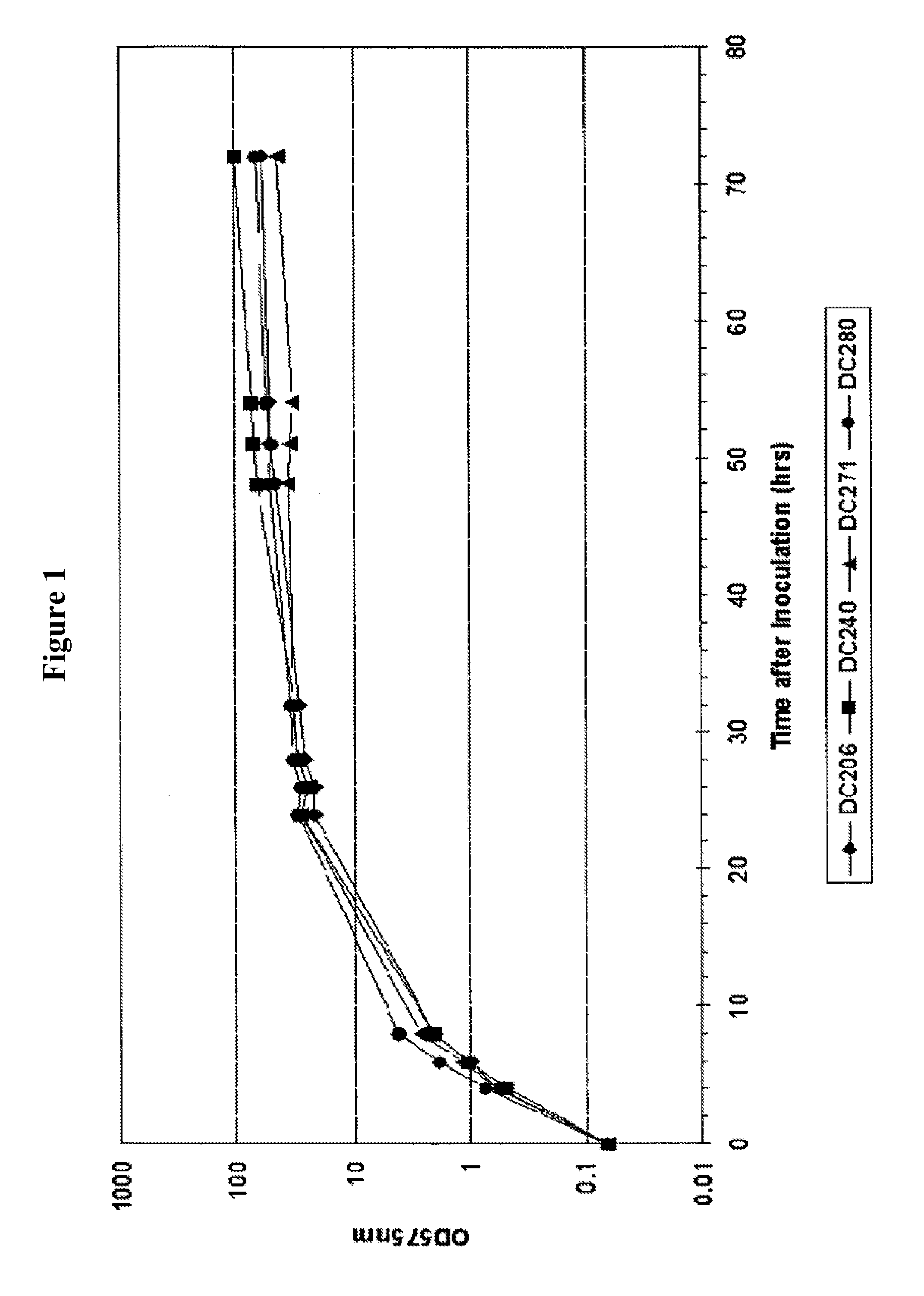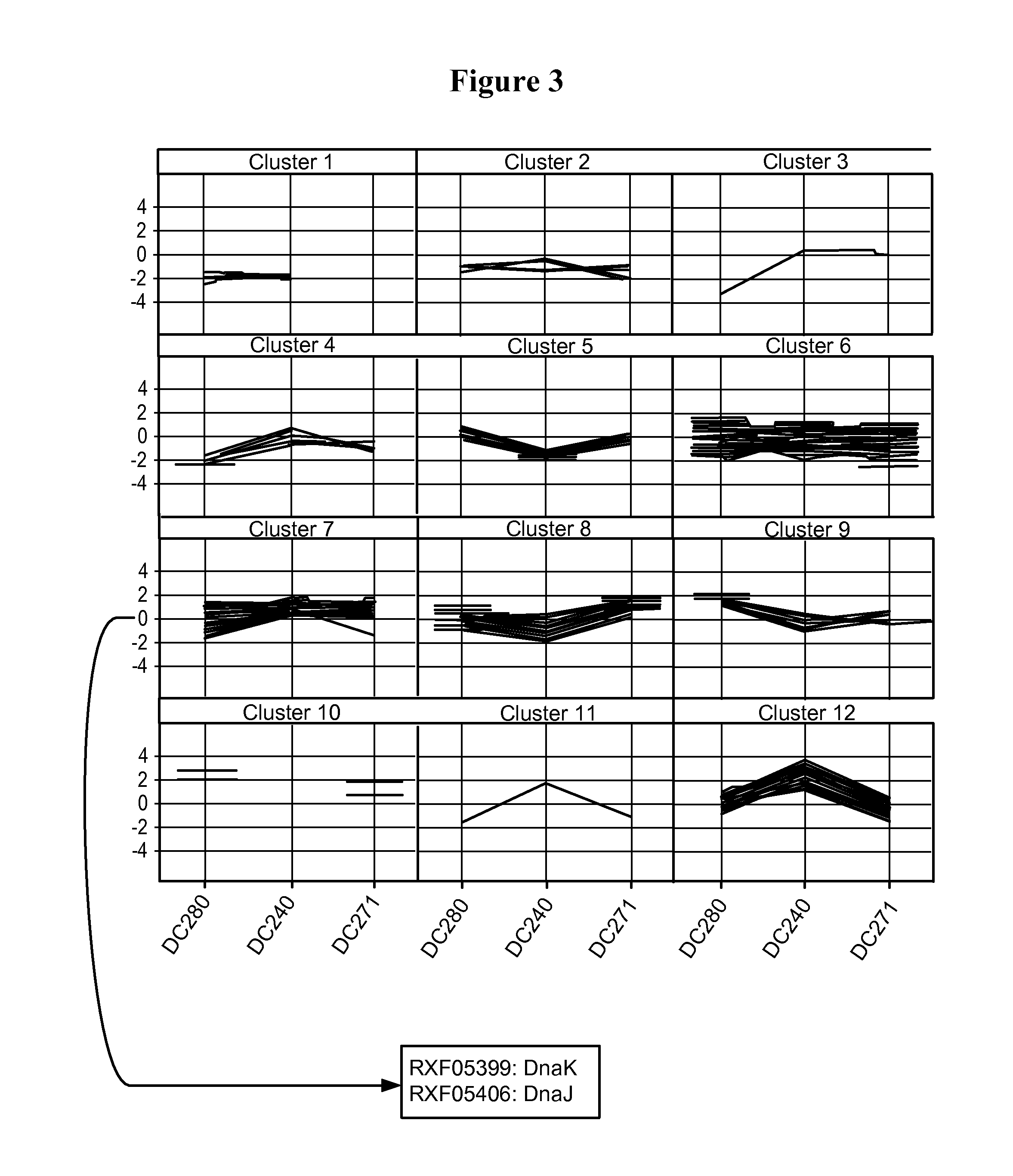Process for improved protein expression by strain engineering
a technology of protein expression and engineering, applied in the field of protein production, can solve the problems of unfavorable efficient use of certain expression systems, unpredictability of proteases, and aggregation of recombinant proteins, and achieve the effects of increasing the amount of protein, increasing the length of time, and increasing the production of recombinant proteins
- Summary
- Abstract
- Description
- Claims
- Application Information
AI Technical Summary
Benefits of technology
Problems solved by technology
Method used
Image
Examples
example 1
Gene Expression Analysis of Strains Producing Cytoplasmic and Periplasmic Proteins—Comparison of Different Timepoints
[0232]To study the FMs and protease gene expression during the production of heterologous protein, P. fluorescens strains DC206, 280, 240 and 271 were used in the initial microarray experiments. DC206 is the host strain and was used as a control for cell growth; DC280 has a vector-only plasmid and was used as a control for the microarray experiments; DC240 is DC206 with a plasmid encoding cytoplasmic nitrilase enzyme that is soluble; DC271 is DC206 with a plasmid encoding the periplasmic human growth hormone (pbp::hGH) that is partly insoluble. Strains were grown in 200 ml of shake flask medium and cell growth was monitored by measuring OD575. IPTG induction was performed 24 hrs after inoculation. All strains grew similarly and culture samples were taken just before (0 hr) and 4 hrs after induction for RNA isolation and transcriptional profiling (TxP) using DNA microa...
example 2
Gene Expression Analysis of Strains Producing Cytoplasmic and Periplasmic Proteins—Ph-eel Comparison gfaifftereza” Strains
[0237]In order to confirm the results obtained above, additional microarray experiments were performed by direct comparison of the two strains DC271 and DC240 (slides 7 to 10 in Table 3). The comparison of the two strains at the 4 hrs after induction time point confirmed that an almost identical set of FM and protease genes were up-regulated in cells expressing partially soluble pbp::hGH (Table 5). All genes listed in Table 5 are significantly (i.e. >2-fold) higher expressed in strains producing the partly insoluble hGH as compared to cells producing fully soluble nitrilase. In the direct comparison of DC271 to DC240, a few additional proteins were identified as compared to the time point comparison (see Table 4) that showed significantly higher gene expression values during partially insoluble hGH production. Those genes included rxf08347 encoding ClpB, rxf04587...
example 3
Gene Expression Analysis of a Strain Producing an Insoluble Cytoplasmic Protein
[0238]Since DC271 expresses partially periplasmic human growth hormone (pbp::hGH), it was investigated if similar or different FMs and protease genes were up-regulated in a strain expressing mainly insoluble cytoplasmic hGH. DC369 was used in this experiment. The 4 hrs after induction sample was compared with that of the 0 hr time point sample, and microarray experiments were performed as shown in Table 3 (slides 11 and 12). Again, similar FM and protease genes were found to be up-regulated indicating that the identified genes are involved in cytoplasmic rather than periplasmic folding and protein degradation (Table 6). A summary of which genes were identified in which experiment along with the fold up-regulation is shown in the Venn diagram of FIG. 4.
TABLE 6List of FM and protease genes whose steady-state mRNA levelsare higher in DC369 at 4 hrs after induction as comparedto time zero. The values listed a...
PUM
| Property | Measurement | Unit |
|---|---|---|
| Fraction | aaaaa | aaaaa |
| Fraction | aaaaa | aaaaa |
| Fraction | aaaaa | aaaaa |
Abstract
Description
Claims
Application Information
 Login to View More
Login to View More - R&D
- Intellectual Property
- Life Sciences
- Materials
- Tech Scout
- Unparalleled Data Quality
- Higher Quality Content
- 60% Fewer Hallucinations
Browse by: Latest US Patents, China's latest patents, Technical Efficacy Thesaurus, Application Domain, Technology Topic, Popular Technical Reports.
© 2025 PatSnap. All rights reserved.Legal|Privacy policy|Modern Slavery Act Transparency Statement|Sitemap|About US| Contact US: help@patsnap.com



